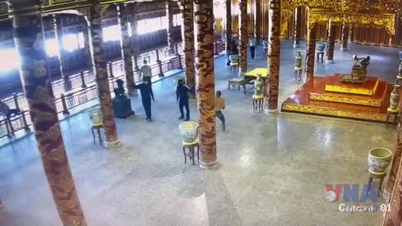Australian scientists have identified the oldest fossil footprints of a "reptile-like" animal on a sandstone slab found near Melbourne.
The discovery suggests that after the first animals evolved onto land about 400 million years ago, they developed the ability to live fully on land much more quickly than previously thought.
"We used to think that the transition from fins to limbs took much longer," says Stuart Sumida, a paleontologist at California State University who was not involved in the study.
Previously, the oldest reptile footprints found in Canada were 318 million years old.
These ancient footprints discovered in sandstone near Melbourne show reptilian-like feet with long toes and curved claws.
Scientists estimate the animal was about 80cm long and may have looked like a modern monitor lizard. The results of the study were published in the journal Nature.
The curved claws were an important clue to identification, according to study co-author Per Ahlberg, a paleontologist at Uppsala University in Sweden: "This was a walking animal."
Only animals that evolved to live entirely on land developed claws. The first vertebrates—fish and amphibians—never developed hard claws and remained dependent on water for egg laying and reproduction.
However, the branch of the evolutionary tree that led to modern reptiles, birds and mammals – known as amniota – developed feet with claws or nails adapted for walking on hard ground. "This is the earliest evidence we've ever seen of an animal with claws," Sumida said.
At the time this ancient reptile lived, the area was hot and humid with vast forests beginning to cover the planet. Australia was then part of the supercontinent Gondwana.
According to Ahlberg, these fossilized footprints record a sequence of events over the course of a single day. A reptile sprinted across the ground before a light rain.
Some rain ruts partially obscured its tracks. Then two more reptiles ran in the opposite direction before the ground hardened and became covered with sediment.
"Fossil traces are great because they tell us how an organism lived, not just what it looked like," said co-author John Long, a paleontologist at Flinders University (Australia).
Source: https://www.vietnamplus.vn/phat-hien-dau-chan-hoa-thach-lau-doi-nhat-cua-bo-sat-tai-australia-post1038574.vnp



![[Photo] Ea Yieng commune settlement project abandoned](https://vphoto.vietnam.vn/thumb/1200x675/vietnam/resource/IMAGE/2025/5/25/57a8177361c24ee9885b5de1b9990b0e)
![[Photo] Funeral of former President Tran Duc Luong in Quang Ngai](https://vphoto.vietnam.vn/thumb/1200x675/vietnam/resource/IMAGE/2025/5/25/ccf19a3d8ea7450bb9afe81731b80995)
![[Photo] French President Emmanuel Macron and his wife begin state visit to Vietnam](https://vphoto.vietnam.vn/thumb/1200x675/vietnam/resource/IMAGE/2025/5/25/03b59c7613144a35ba0f241ded642a59)
![[Photo] Welcoming ceremony for Prime Minister Pham Minh Chinh and his wife on an official visit to Malaysia](https://vphoto.vietnam.vn/thumb/1200x675/vietnam/resource/IMAGE/2025/5/25/dc30203c3ae24da3990266ec3b29bb2d)
![[PHOTO] Hanoi fences off demolition of "Shark Jaws" building](https://vphoto.vietnam.vn/thumb/1200x675/vietnam/resource/IMAGE/2025/5/25/1b42fe53b9574eb88f9eafd9642b5b45)




















































































Comment (0)